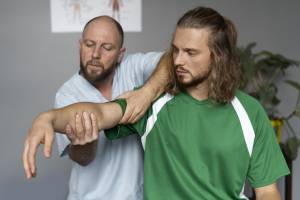Golfer’s elbow, or medial epicondylitis, causes pain and inflammation on the inner elbow. Despite its name, golfer’s elbow affects anyone who repetitively uses forearm muscles or stresses the elbow. Whether you’re an athlete, laborer, or hobbyist, golfer’s elbow can be debilitating. With proper treatment, however, you can recover and resume normal activities.
One of the most effective and holistic ways to manage and treat golfer’s elbow is through physical therapy (PT). Physical therapists are healthcare professionals who specialize in restoring movement, reducing pain, and improving function. If you’re struggling with golfer’s elbow, a physical therapist can play a crucial role in helping you heal, strengthen, and prevent future injury. In this article, we’ll explore how physical therapy can help treat golfer’s elbow, including assessment, treatment modalities, rehabilitation exercises, and preventive strategies.
What is Golfer’s Elbow?

Golfer’s elbow occurs when the tendons that attach to the medial epicondyle (the bump on the inside of your elbow) become inflamed due to overuse or repetitive strain. The condition often develops gradually over time as a result of repeated motions, such as gripping, throwing, or swinging, which stress the forearm muscles and tendons. People who engage in activities like golfing, tennis, baseball, or weightlifting are at higher risk, but it can also affect those who perform repetitive motions at work, such as assembly line workers, carpenters, or computer users.
Common Symptoms of Golfer’s Elbow:
- Pain and tenderness on the inside of the elbow (where the forearm muscles attach)
- Pain that radiates down the forearm
- Stiffness and limited range of motion in the elbow
- Weakness in the hand or wrist, especially when gripping objects, often accompanied by wrist pain.
- Swelling or warmth in the affected area
If left untreated, golfer’s elbow can worsen and limit daily activities, so seeking proper treatment as soon as possible is essential.
How Physical Therapy Helps Treat Golfer’s Elbow?
Physical therapy is a non-invasive, evidence-based treatment option that can provide relief from the symptoms of golfer’s elbow. A physical therapist works with you to assess the extent of the injury, reduce pain, improve flexibility, and restore strength in the affected area. Here’s how a physical therapist can help you recover from golfer’s elbow:

1. Thorough Evaluation and Diagnosis:
When you first visit a physical therapist for golfer’s elbow, they will conduct a comprehensive evaluation. This may include:
- Medical History: A discussion of your symptoms, activities, and any prior injuries or conditions that could contribute to the issue.
- Physical Examination: The therapist will assess the range of motion of your elbow, wrist, and shoulder to identify any limitations in movement. They will also check for tenderness, swelling, and signs of inflammation.
- Functional Assessment: The therapist may evaluate your posture, muscle imbalances, and movement patterns to understand any contributing factors to your condition. This could include assessing your grip strength and evaluating how your forearm muscles and tendons are functioning.
Through this evaluation, the physical therapist can pinpoint the underlying causes of your golfer’s elbow and develop a tailored treatment plan to address it.
2. Pain Management and Inflammation Reduction:
One of the primary goals in treating golfer’s elbow is to reduce pain and inflammation. Your physical therapist may use a variety of modalities to help manage these symptoms:
- Cold Therapy: Applying ice to the affected area can help reduce swelling and numb the pain. Ice packs are typically used during the acute phase (early stages of the injury) to manage inflammation.
- Heat Therapy: After the initial inflammation has decreased, heat can be used to promote blood flow to the area and relax tight muscles and tendons.
- Ultrasound Therapy: This involves the use of sound wave therapy to promote healing by increasing blood flow and reducing muscle spasms.
- Electrical Stimulation: TENS (transcutaneous electrical nerve stimulation) or other forms of electrical therapy can help block pain signals and stimulate the muscles to promote healing.
- Manual Therapy: The therapist may use hands-on techniques, such as massage or joint mobilization, to reduce tension in the muscles and improve mobility.
These treatments help manage pain and create an optimal healing environment for the injured tissues, enabling you to progress to more active forms of rehabilitation.
3. Stretching and Strengthening Exercises:
Once the acute pain subsides, your physical therapist will guide you through a series of stretches and strengthening exercises to rehabilitate your elbow. The goal is to restore flexibility and strength in the forearm muscles and tendons while avoiding overloading the injured area. These exercises might include:
Stretching Exercises:
- Wrist Flexor Stretch: This targets the forearm muscles that attach to the medial epicondyle. The therapist will guide you to extend your arm, palm up, and gently pull back on your hand to stretch the forearm muscles.
- Forearm Extensor Stretch: Though not directly related to the injured area, stretching the forearm extensors can help improve overall elbow flexibility.
Strengthening Exercises:
- Eccentric Strengthening: These exercises involve lengthening the muscle while it is under tension, which has been shown to be effective in treating tendon injuries. Eccentric wrist curls are often recommended to strengthen the forearm flexors without exacerbating the injury.
- Isometric Exercises: In the early stages of rehab, isometric exercises (holding a position without moving) can help build strength without placing excessive stress on the elbow.
- Progressive Strengthening: As the elbow heals, the therapist will gradually increase the difficulty of the exercises by adding resistance or increasing repetitions to build strength in the affected muscles and tendons.
The key is a gradual, progressive approach to ensure the tendon has time to heal and adapt to the stress placed upon it.
4. Addressing Biomechanical Issues:
Sometimes, golfer’s elbow is a result of poor biomechanics or movement patterns. Improper technique in golf, tennis, or weightlifting can put excessive strain on the elbow. A physical therapist can assess your posture, body mechanics, and movement patterns. They identify dysfunctions that may be causing or worsening the injury.
The therapist may provide guidance on improving your technique to reduce strain on the elbow joint and the forearm muscles. This might involve adjustments to your posture, grip, or the way you execute certain movements during sports or activities.
5. Prevention of Future Injuries:
Once you’ve recovered from golfer’s elbow, the physical therapist will work with you on a maintenance plan to prevent reinjury. This could involve:
- Ongoing Stretching and Strengthening: Incorporating regular stretching and strengthening into your routine to maintain flexibility and muscle balance.
- Ergonomics and Activity Modification: If you engage in repetitive activities that contribute to the injury, your therapist can offer ergonomic advice to improve your workstation setup or suggest alternative techniques.
- Progressive Return to Activity: After an injury, returning to full activity too quickly can lead to reinjury. Your physical therapist will help you gradually increase the intensity and duration of your activities to ensure that you’re not overloading the injured tendon.

Conclusion
Golfer’s elbow is painful and frustrating, but with proper care, you can recover and resume activities. Physical therapy is essential in treating golfer’s elbow by addressing pain, inflammation, and improving strength and flexibility. It also corrects movement patterns and helps prevent future injury. Seeking help from a physical therapist can speed up your recovery and restore function.
For athletes, manual laborers, or anyone recovering from overuse, physical therapy offers personalized treatment for golfer’s elbow. If you’re struggling with this condition, consult a physical therapist to start your recovery.

